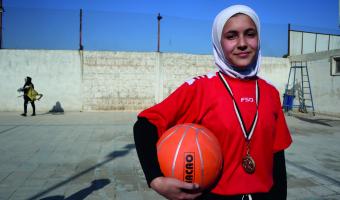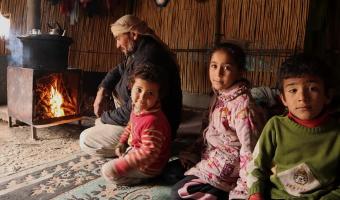When War Comes Home
There has not been a single person in Ukraine left unaffected by the ongoing Russian invasion of their country. Every single day since the 24th of February, 75 Ukrainians have been killed or injured, and 1 in 4 Ukrainians have been forced to flee their homes. Hundreds of thousands do not have a home to return to, and millions more are forced to live without water, electricity, gas supplies and no heating for months. All people in Ukraine live with the threat of rockets and airstrikes; these can bring death and destruction at any time and to any place. Further still, all people in Ukraine live under tremendous psychological pressure—many have suffered scars of war that may not be visible but whose impacts are long lasting.
Outside Ukraine, we can become desensitized to the consequences of the war; however, Albert Lores’ photos serve as a stark reminder that the burden of the war is being borne by people living in Ukraine—innocent people who want to retake the control of their own lives and decisions about the future. These photos, taken across the entire country, and going as far back as the 24th of February, remind us that Ukrainians need our continued support to regain the control of their lives that has been taken away by this war of aggression.
This exhibition aims to bring their stories to light, describe how their lives have changed since Russia invaded their home, and highlight that these are real people with their own faces, families, who could be any of us or our relatives and friends here. The exhibition intends to show the reality of millions of peaceful people trapped in a war that came to their homes.
People in Need
People in Need has been helping people in eastern Ukraine since 2014. In February 2022, our assistance changed. Immediately we increased our team in Ukraine to over 300 employees. We also expanded our operation to almost all oblasts in the country. Since then, we have helped more than half a million people, mainly with delivery of food, water and hygiene, cash assistance, psychosocial support, reconstruction of houses and education. This humanitarian response would be impossible without the strong cooperation of local, regional, and central authorities, 160 local civil society organizations, and funding from the European Union.
EU Humanitarian Aid
The European Union and its Member States are the world’s leading donors of humanitarian aid. Through the Civil Protection and Humanitarian Aid Operations department (ECHO), the European Union helps millions of victims of conflict and disaster every year. With headquarters in Brussels and a global network of field offices, the EU provides assistance to the most vulnerable people on the grounds of humanitarian needs.
This exhibition is funded by the European Union. However, the views and opinions expressed are those of the author(s) only and do not necessarily reflect those of the European Union. Neither the European Union nor the granting authority can be held responsible for them.
Když válka přijde k vám domů
Na Ukrajině nezůstal jediný člověk, kterého by se probíhající ruská invaze nedotkla. Od 24. února bylo každý den zabito nebo zraněno 75 Ukrajinců a každý čtvrtý Ukrajinec byl nucen opustit svůj domov. Statisíce lidí se nemají kam vrátit a další miliony jsou nuceny žít bez vody, elektřiny, dodávek plynu a bez vytápění po celé měsíce. Všichni lidé na Ukrajině žijí s hrozbou raketových a leteckých útoků; ty mohou kdykoli a na kterémkoli místě přinést smrt a zkázu. Dále většina lidí na Ukrajině žije pod obrovským psychickým tlakem - mnozí si nesou válečná zranění, která sice nejsou vidět, ale jejichž dopady jsou dlouhodobé.
Mimo Ukrajinu nemusíme důsledky války tolik vnímat: fotografie Alberta Lorese však slouží jako jasná připomínka toho, že tíhu války nesou lidé žijící na Ukrajině - nevinní lidé, kteří chtějí svůj život a rozhodování o budoucnosti vzít znovu do svých rukou. Tyto fotografie pořizované po celé zemi od 24. února 2022 nám připomínají, že Ukrajinci potřebují naši trvalou podporu, aby znovu získali kontrolu nad svými životy, o kterou je připravila tato agresivní válka.
Cílem této výstavy je přiblížit jejich příběhy, popsat, jak se změnil jejich život od doby, kdy Rusko napadlo jejich rodnou zemi, a zdůraznit, že se jedná o skutečné lidi s vlastní tváří a rodinami, kteří by mohli být kýmkoli z nás nebo našimi příbuznými a přáteli. Výstava chce ukázat realitu milionů mírumilovných lidí, kteří se ocitli v pasti války, jež vtrhla do jejich domovů.
Člověk v tísni
Člověk v tísni pomáhá lidem na východní Ukrajině od roku 2014. V únoru roku 2022 se naše pomoc změnila. Okamžitě jsme náš tým na Ukrajině rozšířili na více než 300 zaměstnanců. Rozšířili jsme také své působení do téměř všech oblastí v zemi. Od té doby jsme pomohli více než půl milionu lidí, především dodávkami potravin, vody a hygienických potřeb, peněžní pomocí, psychosociální podporou, rekonstrukcí domů a vzděláváním. Tato humanitární pomoc by nebyla možná bez silné spolupráce místních, regionálních a ústředních orgánů, 160 místních organizací občanské společnosti a finančních prostředků Evropské unie.
Humanitární pomoc Evropské Unie
Evropská unie a její členské státy jsou největšími světovými dárci humanitární pomoci. Prostřednictvím oddělení civilní ochrany a operací humanitární pomoci (ECHO) Evropská unie každoročně pomáhá milionům obětí konfliktů a katastrof. S ústředím v Bruselu a celosvětovou sítí terénních kanceláří poskytuje EU pomoc nejzranitelnějším lidem na základě jejich humanitárních potřeb.
Tato výstava je financována Evropskou unií. Vyjádřené názory a stanoviska jsou však pouze názory a stanoviska autora a nemusí nutně odrážet názory a stanoviska Evropské unie. Evropská unie ani orgány poskytující dotaci za ně nemohou nést odpovědnost.
Outside Ukraine, we can become desensitized to the consequences of the war; however, Albert Lores’ photos serve as a stark reminder that the burden of the war is being borne by people living in Ukraine—innocent people who want to retake the control of their own lives and decisions about the future. These photos, taken across the entire country, and going as far back as the 24th of February, remind us that Ukrainians need our continued support to regain the control of their lives that has been taken away by this war of aggression.
This exhibition aims to bring their stories to light, describe how their lives have changed since Russia invaded their home, and highlight that these are real people with their own faces, families, who could be any of us or our relatives and friends here. The exhibition intends to show the reality of millions of peaceful people trapped in a war that came to their homes.
People in Need
People in Need has been helping people in eastern Ukraine since 2014. In February 2022, our assistance changed. Immediately we increased our team in Ukraine to over 300 employees. We also expanded our operation to almost all oblasts in the country. Since then, we have helped more than half a million people, mainly with delivery of food, water and hygiene, cash assistance, psychosocial support, reconstruction of houses and education. This humanitarian response would be impossible without the strong cooperation of local, regional, and central authorities, 160 local civil society organizations, and funding from the European Union.
EU Humanitarian Aid
The European Union and its Member States are the world’s leading donors of humanitarian aid. Through the Civil Protection and Humanitarian Aid Operations department (ECHO), the European Union helps millions of victims of conflict and disaster every year. With headquarters in Brussels and a global network of field offices, the EU provides assistance to the most vulnerable people on the grounds of humanitarian needs.
This exhibition is funded by the European Union. However, the views and opinions expressed are those of the author(s) only and do not necessarily reflect those of the European Union. Neither the European Union nor the granting authority can be held responsible for them.
Když válka přijde k vám domů
Na Ukrajině nezůstal jediný člověk, kterého by se probíhající ruská invaze nedotkla. Od 24. února bylo každý den zabito nebo zraněno 75 Ukrajinců a každý čtvrtý Ukrajinec byl nucen opustit svůj domov. Statisíce lidí se nemají kam vrátit a další miliony jsou nuceny žít bez vody, elektřiny, dodávek plynu a bez vytápění po celé měsíce. Všichni lidé na Ukrajině žijí s hrozbou raketových a leteckých útoků; ty mohou kdykoli a na kterémkoli místě přinést smrt a zkázu. Dále většina lidí na Ukrajině žije pod obrovským psychickým tlakem - mnozí si nesou válečná zranění, která sice nejsou vidět, ale jejichž dopady jsou dlouhodobé.
Mimo Ukrajinu nemusíme důsledky války tolik vnímat: fotografie Alberta Lorese však slouží jako jasná připomínka toho, že tíhu války nesou lidé žijící na Ukrajině - nevinní lidé, kteří chtějí svůj život a rozhodování o budoucnosti vzít znovu do svých rukou. Tyto fotografie pořizované po celé zemi od 24. února 2022 nám připomínají, že Ukrajinci potřebují naši trvalou podporu, aby znovu získali kontrolu nad svými životy, o kterou je připravila tato agresivní válka.
Cílem této výstavy je přiblížit jejich příběhy, popsat, jak se změnil jejich život od doby, kdy Rusko napadlo jejich rodnou zemi, a zdůraznit, že se jedná o skutečné lidi s vlastní tváří a rodinami, kteří by mohli být kýmkoli z nás nebo našimi příbuznými a přáteli. Výstava chce ukázat realitu milionů mírumilovných lidí, kteří se ocitli v pasti války, jež vtrhla do jejich domovů.
Člověk v tísni
Člověk v tísni pomáhá lidem na východní Ukrajině od roku 2014. V únoru roku 2022 se naše pomoc změnila. Okamžitě jsme náš tým na Ukrajině rozšířili na více než 300 zaměstnanců. Rozšířili jsme také své působení do téměř všech oblastí v zemi. Od té doby jsme pomohli více než půl milionu lidí, především dodávkami potravin, vody a hygienických potřeb, peněžní pomocí, psychosociální podporou, rekonstrukcí domů a vzděláváním. Tato humanitární pomoc by nebyla možná bez silné spolupráce místních, regionálních a ústředních orgánů, 160 místních organizací občanské společnosti a finančních prostředků Evropské unie.
Humanitární pomoc Evropské Unie
Evropská unie a její členské státy jsou největšími světovými dárci humanitární pomoci. Prostřednictvím oddělení civilní ochrany a operací humanitární pomoci (ECHO) Evropská unie každoročně pomáhá milionům obětí konfliktů a katastrof. S ústředím v Bruselu a celosvětovou sítí terénních kanceláří poskytuje EU pomoc nejzranitelnějším lidem na základě jejich humanitárních potřeb.
Tato výstava je financována Evropskou unií. Vyjádřené názory a stanoviska jsou však pouze názory a stanoviska autora a nemusí nutně odrážet názory a stanoviska Evropské unie. Evropská unie ani orgány poskytující dotaci za ně nemohou nést odpovědnost.


